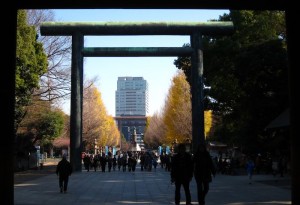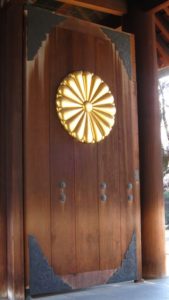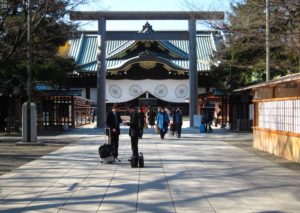After long meetings all week and a late night getting to Tokyo last night I was determined to spend a few hours today with just me and my iPod wandering around Tokyo and trying to recharge a little.
One of the places I did want to visit was the rather controversial Yasukuni-jinja; this is a Shinto shrine that’s a 30-minute walk from the Imperial Palace.

Yasukuni-jinja is dedicated to the spirits of those who died fighting for Japan in the name of the emperor during wartime; it does not have to be a combat death for someone’s spirit to be enshrined here. There are almost 2.5 million names on the register at the shrine.
The short version of the Shinto belief is that the souls of the dead are housed in the shrine. It is believed that all evil or negative acts are forgiven when a person is enshrined here. I guess absolution is probably the closest term in Catholicism. In Shinto once a person is enshrined it is permanent and no one can undo it.
Yasukuni-jinja has huge significance in Japan, it is supposed to give peace to those who fought and died for the emperor, interestingly it is the only place that the emperor ever bows too.
Although the shrine only dates back to 1869 (decidedly modern by Shinto standards) it was chosen in the 1930’s as Tokyo’s major shrine.
The government of the time promoted Yasukuni-jinja as part of its military-first jingoistic policy and it became the memorial to Japans war dead. When state and religion were separated in the post war constitution the enshrinement was supposed to be a strictly religious matter. It’s turned out that over the years the Japanese government has provided information and guidance on enshrinement.

The entrance to the Yasukuni-jinja is very impressive. You pass through two huge Torii gates and a wooden gate with the seal of Imperial Japan on it. At that point the center of the shrine (its “haiden”) is direct in front, again adorned with the Imperial seal.
There were 4 Shinto monks performing some kind of ceremony inside. It’s possible to walk right up to the shrine, and look in. I was feeling rather conspicuous as the only westerner there at this time, and possibly the only non-Shinto in the compound.

This background is there to give some perspective to the controversial parts of what goes on there. Visits by politicians take on huge significance, when former Prime minister Junichiro Koizumi visited there were riots in Taiwan, China and Korea.
Inside Yasukuni-jinja is a physical list of the two and a half million people enshrined there. In 1979 too much controversy it was revealed that the names of 14 class A war criminals had been added to the shrine in the last decade and never announced publicly. The controversy is very political and stronger than ever today. Right wing politicians come here to recognize Japans dead, while the left wing visit to remember the defeat in World War 2 and self defense constitution that the country lives by today.
In total there are more than a thousand convicted war criminals enshrined. In addition to this there are Koreans, Chinese and Taiwanese whose families are not happy about their inclusion.
The war museum on the site does not help matters. It provides quite a lot of information on the occupation of Manchuria in the 30’s, but only mentions the “Nanjing Incident” once in passing. The rest of the world knows it as the Nanjing Massacre where the Japanese killed a huge number of Chinese (Japan says 100,000, China says 300,000).
The same revisionism is evident with the reasons given in the museum for the start of the Second World War. Blame is squarely put on the US and Great Britain for forcing Japan into the war by putting in place a series of sanctions that (according to the museum) forced Japan into the war it wanted no part of.
To be fair it is acknowledged in Japan that the museum presents a somewhat revised version of the first half of the 20th century; to the point that while he was Prime Minister Junichiro Koizumi made a statement in parliament that the history taught in the museum was at odds with that accepted by the Japanese Government. It’s a fascinating place and truthfully, somewhat disturbing.
The country has never apologized for the atrocities and the international image of Japan has suffered somewhat because of that. This museum does not even dismiss them, it chooses to ignore them.
5 Comments
This is as contreversial in Japan as it is in Korea and China. I think most in the county recognize the Yushukan museum does not tell the whole story. Thank you for this, itis important part of the culture.
Useful blog website, keep me personally through searching it. I think you understand the important of shrine to Japanese culture, mainly right wing conservative culture.
This is very good, thank you
This is very controversial, but is possible to copy this article from you? I have place for it.
INteresting
This is very interesting place, certainly well known for being controversial. There is some question over the museum, but there is no boudt of the importance of the shrine, even with the class one war criminals enshrined there. It is an important Shinto temple and you tell a good story here.